
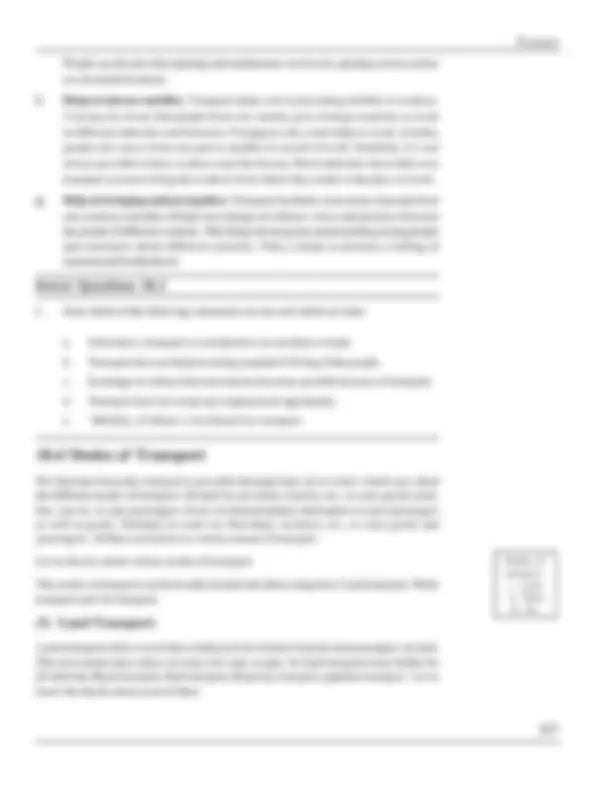
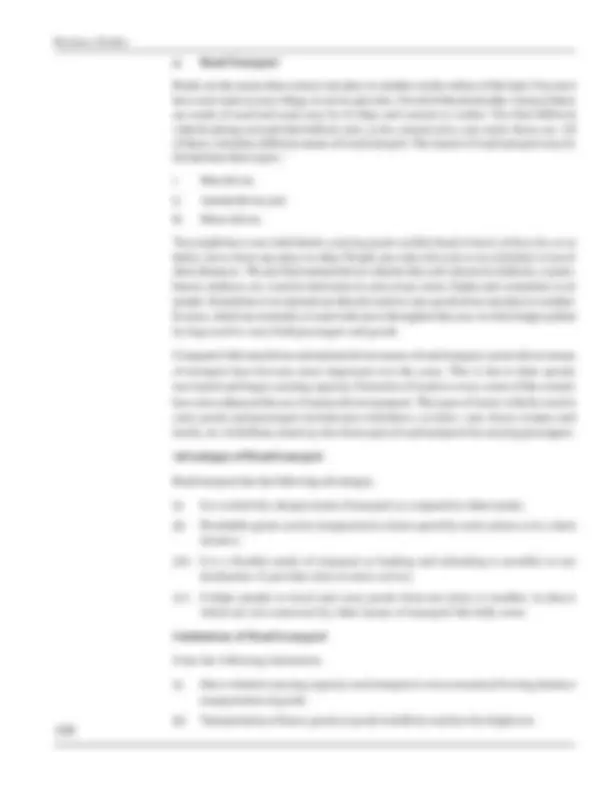
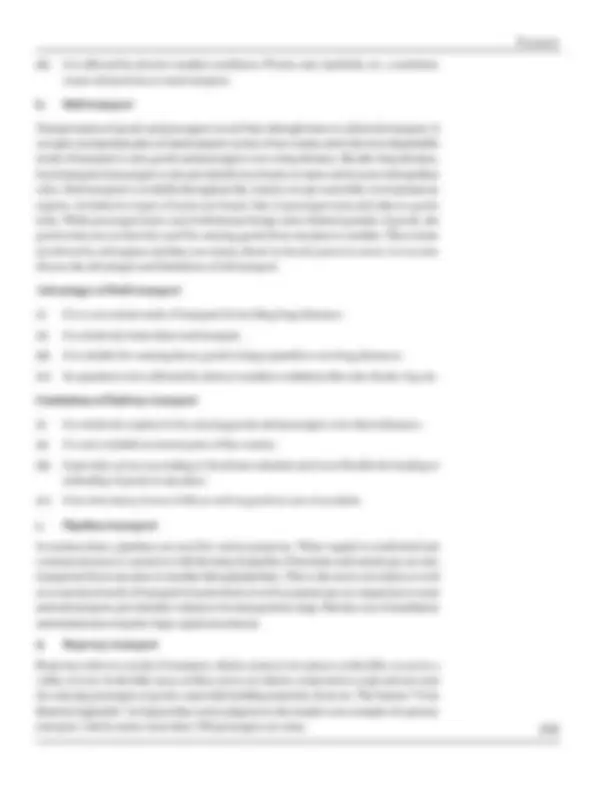
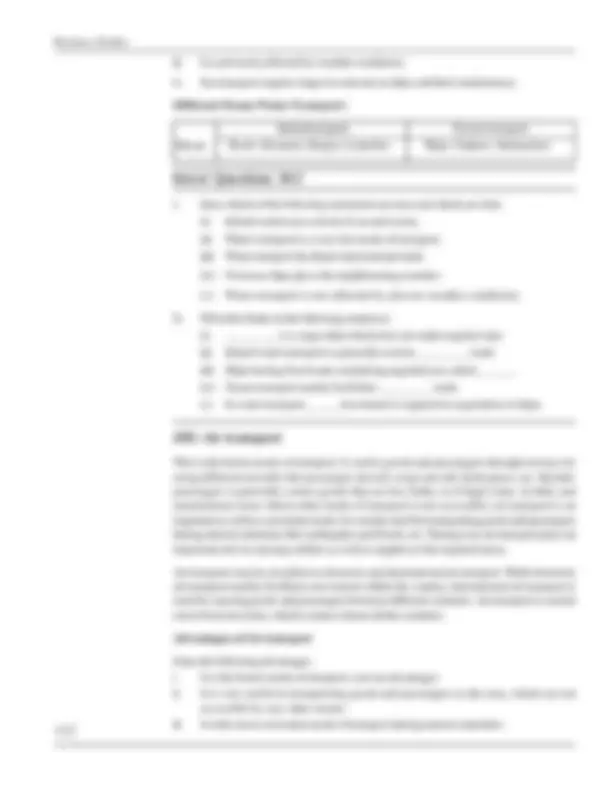
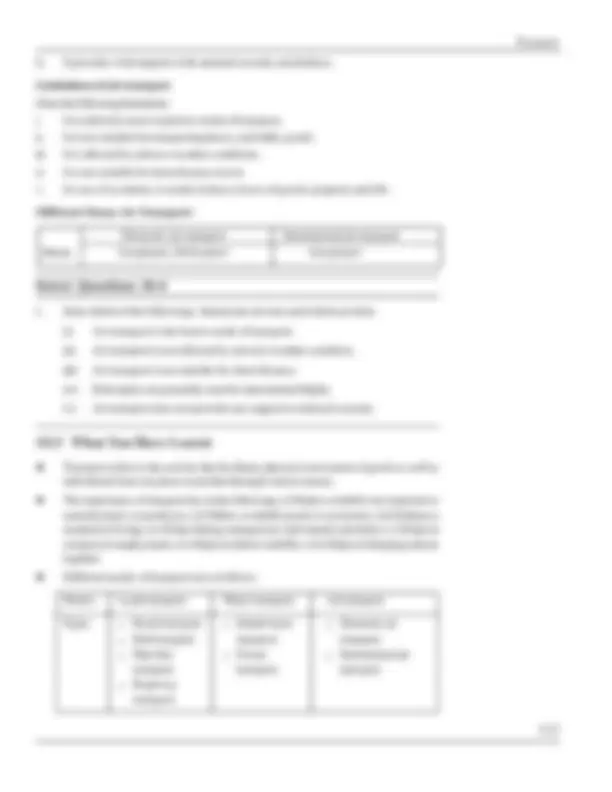



Study with the several resources on Docsity

Earn points by helping other students or get them with a premium plan


Prepare for your exams
Study with the several resources on Docsity

Earn points to download
Earn points by helping other students or get them with a premium plan
Community
Ask the community for help and clear up your study doubts
Discover the best universities in your country according to Docsity users
Free resources
Download our free guides on studying techniques, anxiety management strategies, and thesis advice from Docsity tutors
Transportation subject to be studied
Typology: Study Guides, Projects, Research
1 / 10

This page cannot be seen from the preview
Don't miss anything!







We use various products in our daily life. But do we know where are they produced? Many of them are produced at different places far away from our locality. So how do we get them at our place? These are carried on from all those places through rail, road or air and are made available to us at our locality. You must have seen trucks, tempo, bullock carts etc., which carry products or even raw materials from one place to another. Similarly, you also must have seen people traveling from one place to another by buses, trains, cars, scooters, rickshaws, cycles, etc.
This movement of goods and individuals is very important in business. Because of this, raw materials reach the place of manufacture, finished products reach the place of sale or consumption, individuals move around to manage the business, etc. In this lesson, let us learn how goods and passengers move from one place to another.
After studying this lesson, you will be able to:
! state the meaning of transport; ! recognise the importance of transport; ! identify the various modes of transport; and ! describe the advantages and limitations of different modes of transport.
Transport refers to the activity that facilitates physical movement of goods as well as individuals from one place to another. In business, it is considered as an auxiliary to trade, that means, it supports trade and industry in carrying raw materials to the place of production and distributing finished products for consumption. Individuals or business firms that engage
Business Studies
themselves in such activities are called transporters. Generally, transporters carry raw material, finished products, passangers, etc. from one place to another. So it removes the distance barrier. Now-a-days goods produced at one place are readily available at distant places. People move freely throughout the world because of transport. It is associated with every step of our life. Without transport, we, as well as business units cannot move a singe step. Let us discuss its importance.
Followings are the points of importance of transport. a. Makes available raw materials to manufacturers or producers: Transport makes it possible to carry raw materials from places where they are available, to places where they can be processed and assembled into finished goods. b. Makes available goods to customers: Transport makes possible movement of goods from one place to another with great ease and speed. Thus, consumers spread in different parts of the country have the benefit of consuming goods produced at distant places. c. Enhances standard of living: Easy means of transport facilitates large-scale production at low costs. It gives consumers the choice to make use of different quantities of goods at different prices. So it raises the standard of living of the people. d. Helps during emergencies and natural calamities: In times of national crisis, due to war or internal disturbance, transport helps in quick movement of troops and the supplies needed in the operation. e. Helps in creation of employment: Transport provides employment opportunity to individuals as drivers, conductors, pilots, cabin crew, captain of the ship, etc. who are directly engaged in transport business. It also provides employment to people indirectly in the industries producing various means of transport and other transport equipments.
Business Studies
a. Road Transport
Roads are the means that connect one place to another on the surface of the land. You must have seen roads in your village, in towns and cities. Not all of them look alike. Some of them are made of sand and some may be of chips and cement or coaltar. You find different vehicles plying on roads like bullock carts, cycles, motorcycles, cars, truck, buses, etc. All of these constitute different means of road transport. The means of road transport may be divided into three types: -
i. Man driven; ii. Animal driven; and iii. Motor driven.
You might have seen individuals carrying goods on their head or back, in bicycles or on thelas, move from one place to other. People also ride a bicycle or use rickshaw to travel short distances. We also find animal driven vehicles like carts (drawn by bullocks, camels, horses, donkeys, etc.) used in rural areas to carry crops, straw, fodder and sometimes even people. Sometimes even animals are directly used to carry goods from one place to another. In areas, which are normally covered with snow throughout the year, we find sledges pulled by dogs used to carry both passengers and goods.
Compared with man driven and animal-driven means of road transport, motor driven means of transport have become more important over the years. This is due to their speedy movement and larger carrying capacity. Extension of roads to every corner of the country have also enhanced the use of motor driven transport. The types of motor vehicles used to carry goods and passengers include auto-rickshaws, scooters, vans, buses, tempos and trucks, etc. In Kolkata, tramway also forms part of road transport for carrying passengers.
Advantages of Road transport
Road transport has the following advantages.
(i) It is a relatively cheaper mode of transport as compared to other modes. (ii) Perishable goods can be transported at a faster speed by road carriers over a short distance. (iii) It is a flexible mode of transport as loading and unloading is possible at any destination. It provides door-to-door service. (iv) It helps people to travel and carry goods from one place to another, in places which are not connected by other means of transport like hilly areas.
Limitations of Road transport
It has the following limitations.
(i) Due to limited carrying capacity road transport is not economical for long distance transportation of goods. (ii) Transportation of heavy goods or goods in bulk by road involves high cost.
Transport
(iii) It is affected by adverse weather conditions. Floods, rain, landslide, etc., sometimes create obstructions to road transport.
b. Rail transport
Transportation of goods and passengers on rail lines through trains is called rail transport. It occupies an important place in land transport system of our country and is the most dependable mode of transport to carry goods and passengers over a long distance. Besides long distance, local transport of passengers is also provided by local trains or metro-rail in some metropolitan cities. Rail transport is available throughout the country except some hilly or mountainous regions. In India two types of trains are found. One is passenger train and other is goods train. While passenger trains carry both human beings and a limited quantity of goods, the goods trains are exclusively used for carrying goods from one place to another. These trains are driven by rail engines and they use steam, diesel or electric power to move. Let us now discuss the advantages and limitations of rail transport.
Advantages of Rail transport
(i) It is a convenient mode of transport for travlling long distances.
(ii) It is relatively faster than road transport.
(iii) It is suitable for carrying heavy goods in large quantities over long distances.
(iv) Its operation is less affected by adverse weathers conditions like rain, floods, fog, etc.
Limitations of Railway transport
(i) It is relatively expensive for carrying goods and passengers over short distances.
(ii) It is not available in remote parts of the country.
(iii) It provides service according to fixed time schedule and is not flexible for loading or unloading of goods at any place.
(iv) It involves heavy losses of life as well as goods in case of accident.
c. Pipelines transport
In modern times, pipelines are used for various purposes. Water supply to residential and commercial areas is carried on with the help of pipeline. Petroleum and natural gas are also transported from one place to another through pipelines. This is the most convenient as well as economical mode of transport for petroleum as well as natural gas in comparison to road and rail transport, provided the volume to be transported is large. But the cost of installation and maintenance requires large capital investment.
d. Ropeway transport
Ropeway refers to a mode of transport, which connects two places on the hills, or across a valley or river. In the hilly areas, trolleys move on wheels connected to a rope and are used for carrying passengers or goods, especially building materials, food, etc. The famous “Uran Khatola Jagdamba” in Gujarat that carries pilgrims to the temple is an example of ropeway transport, which carries more than 100 passengers at a time.
Transport
I. Inland water transport
Inland water transport use boats, launches, barges, streamers, etc., to carry goods and passengers on river and canal routes. These routes are called inland waterways and are used in domestic or home trade to carry bulky goods. Passenger transport through waterways is not so popular in our country. Inland water transport system exists only in few states like. West Bengal, Andhra Pradesh, Assam, Tamil Nadu, etc.
II. Ocean transport
Ocean transport refers to movement of goods and passengers with the help of ships through sea or ocean waterways. It plays an important role in the development of international trade. It is also used for transporting goods and passengers in the coastal areas. Ocean transport has its fixed route, which links almost all the countries of the world. Sea transport may be of the following two types.
i. Coastal Shipping - In this transport, ships ply between the main ports of a country. This helps in home trade, and also in carrying passengers within the country.
ii. Overseas shipping - In this transport, ships ply between different countries separated by sea or ocean. It is mainly used for promotion and development of international trade. It is economical means of transport to carry heavy machines and goods in bulk. Overseas transport is carried out on fixed routes, which connect almost all the countries. In ocean transport, different types of ships are used to carry passengers and goods. These may be classified as under. a. Liners - A liner is a passenger or cargo vessel, which belongs to a regular shipping company. These ships ply over a fixed route according to a prescribed schedule or timetable. b. Tramps - A tramp is a cargo ship, which does not make regular trips but plies whenever cargo is offered to it. It does not follow a fixed route or a prescribed timetable like that of liners.
Advantages of water transport
Water Transport has the following advantages:
a. It is a relatively economical mode of transport for bulky and heavy goods.
b. It is a safe mode of transport with respect to occurance of accidents.
c. The cost of maintaining and constructing routes is very low as most of them are naturally made.
d. It promotes international trade.
Limitations of water transport
Water transport has the following limitations.
i. The depth and navigability of rivers and canals vary and thus, affect operations of different transport vessels.
ii. It is a slow moving mode of transport and therefore not suitable for transport of perishable goods.
Business Studies
iii. It is adversely affected by weather conditions. iv. Sea transport requires large investment on ships and their maintenance.
Different Means Water Transport :
Inland transport Ocean transport Means Boats, Steamers, Barges, Launches Ships, Tankers, Submarines
I. State which of the following statements are true and which are false. (i) Inland waterways consist of sea and ocean. (ii) Water transport is a very fast mode of transport. (iii) Water transport facilitates international trade. (iv) Overseas ships ply to the neighbouring countries (v) Water transport is not affected by adverse weather conditions.
II. Fill in the blanks in the following sentences: (i) _________ is a cargo ship which does not make regular trips. (ii) Inland water transport is generally used in _________ trade. (iii) Ships having fixed routes and plying regularly are called ______. (iv) Ocean transport mainly facilitates _________ trade. (v) In water transport, _____ investment is required in acquisition of ships.
This is the fastest mode of transport. It carries goods and passengers through airways by using different aircrafts like passenger aircraft, cargo aircraft, helicopters, etc. Besides passengers it generally carries goods that are less bulky or of high value. In hilly and mountainous areas where other mode of transport is not accessible, air transport is an important as well as convenient mode. It is mostly used for transporting goods and passengers during natural calamities like earthquake and floods, etc. During war, air transport plays an important role in carrying soldiers as well as supplies to the required areas.
Air transport may be classified as domestic and international air transport. While domestic air transport mainly facilitates movement within the country, international air transport is used for carrying goods and passengers between different countries. Air transport is carried out in fixed air routes, which connect almost all the countries.
Advantages of Air transport
It has the following advantages. i. It is the fastest mode of transport. (not an advantage) ii. It is very useful in transporting goods and passengers to the area, which are not accessible by any other means. iii. It is the most convenient mode of transport during natural calamities.
Business Studies
! The different means of water transport to carry goods and passengers are
Inland transport Ocean transport Means Boats, Steamers, Barges, Launches Ships, Tankers, Submarines ! The different means of air transport to carry goods and passengers are Domestic air transport International air transport Means Aeroplanes, Helicopters Aeroplanes
10.1 I True- a, c, e. False- b, d. 10.2 I Correct- ii, v Wrong- i, iii, iv II i. d ii. a iii. e iv. b v. c 10.3 I True iii, iv False i, ii, v II i. Tramp ii. Home/Domestic iii. Liners iv. Foreign v. Heavy 10.4 I True i, iii False ii, iv, v
1 Observe the various modes of transport near your residence and write their advantages and disadvantages. 2 Visit the nearest market of your area and ask the trader which mode of transport they are using and why? 3 In your family, what modes of transport are being used on different occasions? Make a list.
Ropeway transport Man driven Ropes
Animal driven
Motor driven
Rail transport
Pipeline transport Pipes
Road transport
! The different means of land transport to carry goods and passengers are